Disocactus ackermannii 101: Care and Propagation Simplified
Picture a cactus, but not the typical spiky one we see in deserts. This amazing plant, called Disocactus ackermannii, is a true nature’s wonder! Instead of growing on the ground, it prefers to call trees and other plants its home, clinging to them like a friendly neighbor. Imagine finding one of these beauties nestled among the lush greenery of tropical Mexican forests!
But wait, there’s more! This cactus has a unique look that sets it apart. It starts with a small, circular base, and then branches out into long, curved leaves that almost seem to wave at you. And when it’s time to bloom, get ready for a vibrant display of red flowers that will leave you in awe.
Intrigued? Keep reading to uncover more fascinating details about this extraordinary cactus and its incredible journey from tiny seeds to a living work of art.

Related Post:
16 Types of Disocactus With Pictures
Contents
Disocactus ackermannii Care Guide
Caring for an Disocactus ackermannii might seem daunting, but fear not! They’re actually low-maintenance companions that can bloom twice a year if you provide the right conditions. Let’s dive into the specifics of keeping these beauties happy and healthy.
Light
Disocactus ackermannii thrives on sunlight! Make sure to give them plenty of exposure, especially during the summer months. A great idea is to let them bask in the morning and evening sun, but move them to a shady spot around noon to avoid the intense midday heat.
If the weather gets too hot or too cold, it’s best to bring your cactus friend indoors for a cozy staycation. And if you live in a tropical paradise, you can keep them outside all year round – how lucky!

Water
During the growing season, these cacti love a good soak. Make sure to give them a thorough watering, flooding the pot until the soil is completely soaked. But don’t forget to let the soil dry out before the next watering session – these plants hate having wet feet!
Just like their desert cousins, Disocactus ackermannii appreciates the “soak and dry” method. Overwatering is a no-no, so make sure they’re not sitting in a puddle of water.
When it’s time for their winter nap, you can cut back on watering. If temperatures dip below 50°F (10°C), your cactus can go without water for longer periods, allowing it to rest and recharge for the next growing season.
Soil
Drainage is key for Disocactus ackermannii! They love soil that’s pebbly or sandy, which allows excess water to flow away easily. This prevents root damage caused by too much moisture hanging around.
A soil mix with 40-50% organic matter is ideal, providing the perfect balance of nutrients and drainage. And don’t forget about the pot! Unglazed ceramic pots are great for these cacti because they’re porous, allowing air and water to move through easily.
Fertilizer
Since Disocactus ackermannii grows slowly, their shallow roots appreciate a little extra nutrition. Liquid fertilizers are the way to go, providing a steady supply of nutrients as you water.
During the growing season, you can treat them to a balanced fertilizer (with nitrogen, phosphorus, and potassium) once a month. You can also use a special cactus fertilizer to encourage those gorgeous blooms.
But when it’s time for their winter break, hold off on the fertilizer. The last feeding should be in August or September, and you can resume once spring rolls around again.
Pests and Diseases
Disocactus ackermannii is generally a tough cookie, but there are a few pests and diseases to keep an eye out for:
- Mealybugs: These pesky critters might show up as white fluff on the branches, causing discoloration or needle drop. But don’t worry, they’re easy to get rid of with an insecticide.
- Spider mites: If your cactus stays too moist, especially in summer, it might attract these unwanted guests. Insecticides can help get rid of them, too.
- Root rot: Like most cacti, Disocactus ackermannii is susceptible to root rot if the soil doesn’t drain well. The key is making sure excess water can escape quickly.
If you notice any signs of pests or disease, isolate your plant right away and clear away any fallen flowers or debris, which can attract pests as they decompose.

Disocactus ackermannii Propagation
Seeds
- Plant the seeds in a good soil mix designed for cacti and succulents
- Place the seed tray or pot in a partially shaded area
- Keep the soil moist but not waterlogged until seeds germinate
- Minimum temperature should be around 72°F (22°C) for successful germination
Cuttings
- Take stem cuttings at least 1 inch long using clean pruning shears or scissors
- Allow the cuttings to callus over for 2-3 weeks before planting
- The calloused area will form a dry seal to prevent rot after planting
- Plant the calloused cuttings in a well-draining soil mix
- Wait 2 more weeks before beginning to water the new cuttings
- Once rooted, the propagated plants can be transplanted to their permanent pots
- From the initial cutting, it takes around 6-12 weeks for the new plants to be ready for repotting
- Maintain minimum temperatures around 72°F (22°C) during root establishment
With a little patience, you can easily propagate new Disocactus ackermannii from seeds or stem cuttings using these simple steps! Both methods allow you to expand your collection of these unique epiphytic cacti.
